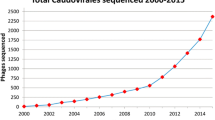Abstract
Genomics has greatly transformed our understanding of phage biology; however, traditional methods of DNA isolation for whole genome sequencing have required phages to be grown to high titers in large-scale preparations, potentially selecting for only those phages that can grow efficiently under laboratory conditions. This may also select for mutations or deletions that enable more efficient growth in culture. The ability to sequence a bacteriophage genome from a single isolated plaque reduces these risks while decreasing the time and complexity of bacteriophage genome sequencing. A method of amplification and library preparation is described, utilizing Sequence Independent Single Primer Amplification (SISPA), that can be used for whole genome shotgun sequencing of bacteriophages from a single isolated plaque.
Access this chapter
Tax calculation will be finalised at checkout
Purchases are for personal use only
Similar content being viewed by others
References
Allander T, Emerson SU, Engle RE, Purcell RH, Bukh J (2001) A virus discovery method incorporating DNase treatment and its application to the identification of two bovine parvovirus species. Proc Natl Acad Sci U S A 98(20):11609–11614
Breitbart M, Rohwer F (2005) Method for discovering novel DNA viruses in blood using viral particle selection and shotgun sequencing. Biotechniques 39(5):729–736
van der Hoek L, Pyrc K, Jebbink MF, Vermeulen-Oost W, Berkhout RJ, Wolthers KC et al (2004) Identification of a new human coronavirus. Nat Med 10(4):368–373
Jones MS, Kapoor A, Lukashov VV, Simmonds P, Hecht F, Delwart E (2005) New DNA viruses identified in patients with acute viral infection syndrome. J Virol 79(13):8230–8236
Palmenberg AC, Spiro D, Kuzmickas R, Wang S, Djikeng A, Rathe JA et al (2009) Sequencing and analyses of all known human rhinovirus genomes reveal structure and evolution. Science 324(5923):55–59
Djikeng A, Halpin R, Kuzmickas R, Depasse J, Feldblyum J, Sengamalay N et al (2008) Viral genome sequencing by random priming methods. BMC Genomics 9:5
Agindotan BO, Ahonsi MO, Domier LL, Gray ME, Bradley CA (2010) Application of sequence-independent amplification (SIA) for the identification of RNA viruses in bioenergy crops. J Virol Methods 169(1):119–128
Victoria JG, Kapoor A, Dupuis K, Schnurr DP, Delwart EL (2008) Rapid identification of known and new RNA viruses from animal tissues. PLoS Pathog 4(9):e1000163
Froussard P (1992) A random-PCR method (rPCR) to construct whole cDNA library from low amounts of RNA. Nucleic Acids Res 20(11):2900
Depew J, Zhou B, McCorrison JM, Wentworth DE, Purushe J, Koroleva G et al (2013) Sequencing viral genomes from a single isolated plaque. Virol J 10:181
Reyes GR, Kim JP (1991) Sequence-independent, single-primer amplification (SISPA) of complex DNA populations. Mol Cell Probes 5(6):473–481
Moser LA, Ramirez-Carvajal L, Puri V, Pauszek SJ, Matthews K, Dilley KA et al (2016) A universal next-generation sequencing protocol to generate noninfectious barcoded cdna libraries from high-containment rna viruses. mSystems 1(3):e00039
Wright MS, Stockwell TB, Beck E, Busam DA, Bajaksouzian S, Jacobs MR et al (2015) SISPA-Seq for rapid whole genome surveys of bacterial isolates. Infect Genet Evol 32:191–198
Gaillard C, Strauss F (1990) Ethanol precipitation of DNA with linear polyacrylamide as carrier. Nucleic Acids Res 18(2):378
Hartley JL, Bowen H (1996) PEG precipitation for selective removal of small DNA fragments. Focus 18(1):27
Hall RJ, Wang J, Todd AK, Bissielo AB, Yen S, Strydom H et al (2014) Evaluation of rapid and simple techniques for the enrichment of viruses prior to metagenomic virus discovery. J Virol Methods 195:194–204
Bartram A, Poon C, Neufeld J (2009) Nucleic acid contamination of glycogen used in nucleic acid precipitation and assessment of linear polyacrylamide as an alternative co-precipitant. Biotechniques 47(6):1019–1022
Frackman S, Kobs G, Simpson D, Storts D (1998) Betaine and DMSO: Enhancing Agents for PCR. Promega Notes 65:27–30
Acknowledgments
The author wishes to thank Galina Koroleva, Jessica DePew, Janaki Purushe, Bin Zhou, and Manolito Torralba for their contributions to the development of these protocols. This work was supported with funds from the United States National Institutes of Health (R21-DE018063 and U54-AI84844) and in part with funds from the National Institute of Allergy and Infectious Diseases, National Institutes of Health, Department of Health and Human Services under contract number HHSN272200900007C.
Author information
Authors and Affiliations
Corresponding author
Editor information
Editors and Affiliations
Rights and permissions
Copyright information
© 2018 Springer Science+Business Media LLC
About this protocol
Cite this protocol
Fouts, D.E. (2018). Amplification for Whole Genome Sequencing of Bacteriophages from Single Isolated Plaques Using SISPA. In: Clokie, M., Kropinski, A., Lavigne, R. (eds) Bacteriophages. Methods in Molecular Biology, vol 1681. Humana Press, New York, NY. https://doi.org/10.1007/978-1-4939-7343-9_12
Download citation
DOI: https://doi.org/10.1007/978-1-4939-7343-9_12
Published:
Publisher Name: Humana Press, New York, NY
Print ISBN: 978-1-4939-7341-5
Online ISBN: 978-1-4939-7343-9
eBook Packages: Springer Protocols




